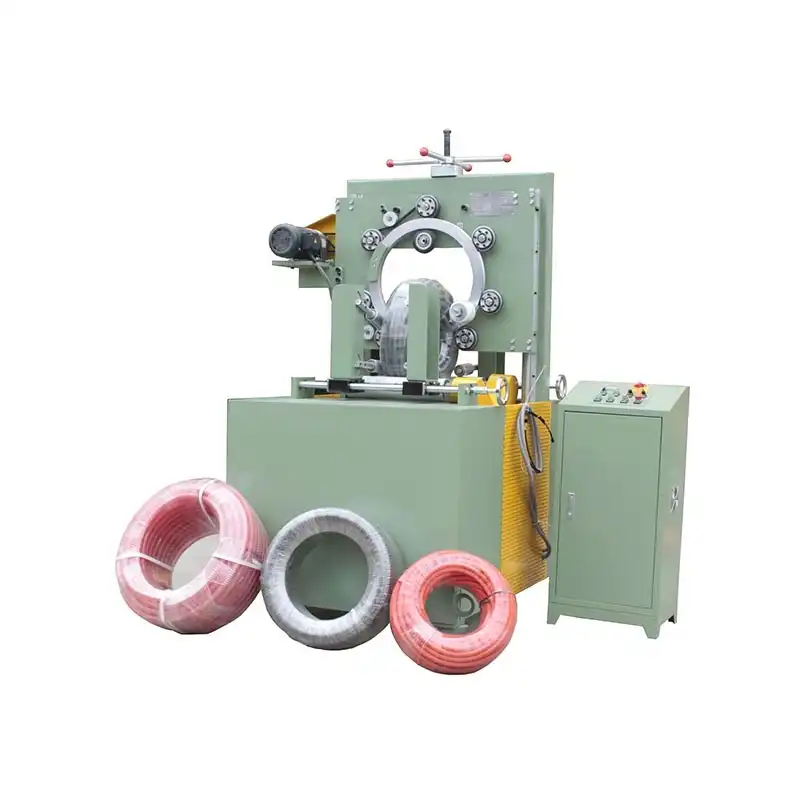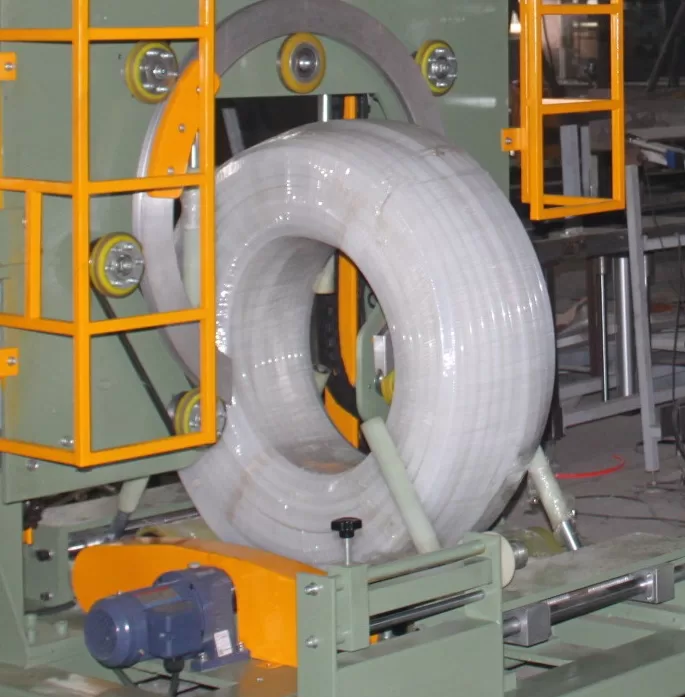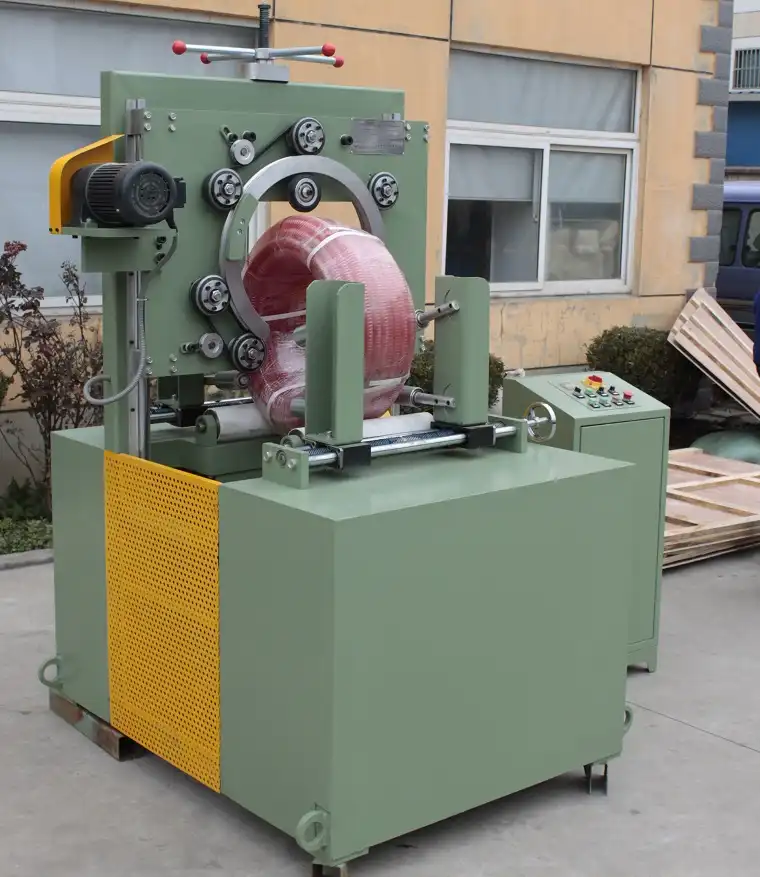Hydrology Drip Pipe Packing Machine

A hydrology drip pipe packing machine, often referred to as an irrigation pipe coiling or packaging machine, is specialized automated equipment designed for efficiently packaging long lengths of drip irrigation tubing. Drip irrigation systems rely on these pipes to deliver water directly to the root zone of plants, significantly improving water efficiency in agriculture. This machine addresses the challenge of handling and packaging these often bulky and flexible pipes into compact, manageable coils suitable for storage, transport, and deployment.
1. The Role of Automated Drip Pipe Packaging
Manual coiling and packing of drip pipes can be labor-intensive, time-consuming, and lead to inconsistencies in coil size and quality. An automated drip pipe packing machine streamlines this process, offering significant advantages for manufacturers and distributors of irrigation supplies. It takes extruded drip pipe, typically fed directly from the production line or a large spool, and processes it into neatly wound and secured coils.
2. How a Drip Pipe Packing Machine Works: Step-by-Step Process
While specific designs may vary, the core operation of a hydrology drip pipe packing machine generally follows these steps:
- Pipe Infeed: The machine carefully guides the drip pipe from the source (e.g., extruder or payoff stand) into the processing area, often using rollers or guides to prevent kinking or damage.
- Length Measurement: A precision measurement system (like an encoder wheel) accurately tracks the length of the pipe being fed into the machine. This ensures each coil meets the specified length requirement.
- Coiling/Winding: The pipe is wound onto a coiling head or mandrel. The machine controls the winding tension and traverse motion to create a uniform, tightly wound coil of the desired diameter and width.
- Cutting: Once the target length is reached, an integrated cutting mechanism (e.g., shear cutter, rotary blade) cleanly severs the pipe.
- Coil Securing: The completed coil is typically secured using automated strapping (applying plastic or metal straps) or wrapping (using stretch film) to maintain its shape and prevent unwinding during handling.
- Coil Ejection/Discharge: The finished, secured coil is automatically ejected from the coiling head onto a conveyor, collection table, or directly into a subsequent packaging station (like boxing or bagging).

plastic pipe coil wrapping machine 3. Key Components and Features
Understanding the main components helps appreciate the machine's functionality:
- Infeed Guide System: Ensures smooth, tension-controlled feeding of the pipe.
- Measuring Device: High-accuracy length counter (e.g., encoder wheel).
- Coiling Head/Mandrel: The core component onto which the pipe is wound. Often adjustable for different coil diameters.
- Traverse System: Guides the pipe back and forth across the coiling head to create even layers.
- Cutting Unit: Automated cutter for precise pipe severing.
- Strapping/Wrapping Unit: Applies straps or film to secure the coil. This can be integrated or a separate module.
- Control System (PLC): The machine's brain, typically a Programmable Logic Controller (PLC) with a Human-Machine Interface (HMI).
- Centrally controls and synchronizes all operations (feeding speed, length measurement, cutting, coiling speed, strapping).
- Allows operators to input parameters like desired pipe length per coil, coil dimensions, number of straps, etc.
- Stores recipes for different product specifications.
- Provides diagnostics and operational status.
- Optional Packing Station: As mentioned previously, this station can automatically place finished coils into boxes, bags, or other tertiary packaging.
- Places the cut and sealed tube sections into boxes, bags or other packaging types.
- Ensures the tubing remains clean and intact inside the package.
4. Benefits of Using Automated Drip Pipe Packing Machines
Implementing an automated hydrology drip pipe packing machine offers substantial advantages:
- Increased Productivity: Machines operate significantly faster than manual methods, drastically increasing output.
- Consistent Quality: Produces uniform coils with precise lengths and secure packaging every time, enhancing product presentation and reliability.
- Reduced Labor Costs: Automation minimizes the need for manual labor in the coiling and packing process, freeing up personnel for other tasks.
- Improved Safety: Reduces manual handling of potentially heavy or unwieldy pipe lengths, minimizing risks of repetitive strain injuries.
- Material Savings: Precise length control minimizes pipe wastage, and optimized packaging can reduce the consumption of strapping or wrapping materials.
- Enhanced Logistics: Compact, uniform coils are easier and more cost-effective to handle, stack, store, and transport.
- Reduced Pipe Damage: Gentle, controlled handling minimizes the risk of kinks, scratches, or other damage during packaging.

pipe coil wrap machine3 5. Conclusion
The hydrology drip pipe packing machine is an indispensable tool in the modern manufacturing of irrigation systems. By automating the critical process of coiling and packaging drip tubing, it enhances efficiency, ensures consistent product quality, reduces operational costs, and contributes to the effective deployment of water-saving drip irrigation technology. Understanding its operation and benefits highlights its importance in supporting sustainable agricultural practices through improved benefits of drip irrigation systems.